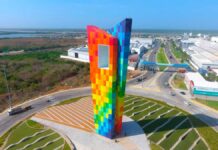The Convent and Church of San Diego in Cartagena de Indias, is located in the San Diego neighborhood, in the historic center of the heroic city.
In the year 1608, more precisely on February 8, Father Fray Sebastian de Humillas obtained a license for the construction and founding of the Convent of Recoletos de San Diego in the city of Cartagena de Indias. This process would begin in a house that little by little would be transformed into the Convent.
The work would not have been possible without the pecuniary contributions of the citizens, the good intentions of Bishop Fray Juan de Ladrada and the then Governor Don Diego Fernando de Velasco. It would not be until 1611 that the construction of the Convent of San Diego would begin, being paid for by Captain Jorge Fernández Gramajo.
Also learn about the history of the Church of Santo Toribio in Cartagena)
On October 21, 1625, the Church of the Monastery was consecrated and this date is known as the date of completion of the works of the Convent of San Diego or Recoleto. The construction was carried out by the master Simon Gonzalez, who planned and directed the construction of the Cartagena Cathedral. The uses that the building has had are varied.
In 1857 it appeared in the Inventory of National Real Estate, listed as a prison for the province and the district of Cartagena, as the House of Prison and Detention. This cloister had other surrounding properties that at some point tried to be sold or auctioned off.
The inventory of the Convent included an orchard, which in 1881 an attempt was made to sell and when no bidder appeared for the auction on August 31 of the same year, the property administrator of the province awarded it to the General Inventory of the State. By the year 1891, the Franciscan community of San Diego was completely extinct, the cloister continued its work as a prison center. When José Manuel Gogenaga was governor, the city's electrical plant was installed on the first floor of the building, which exploded in 1905, causing extensive damage to the building.
(Also learn about the history of the Plaza de San Diego in Cartagena de Indias)
As was the custom of the time, buildings of a religious nature allocated part of their land to holy fields or cemeteries, and the cloister of San Diego was no exception. In 1917, its transfer was ordered so that the administration of the Liquor Monopoly could be installed on said land.
In 1957, as governor Eduardo Lemaitre, and according to a report from the then departmental secretary of education, it was agreed to move the Musical and Fine Arts Institute to the convent, in search of a better location. Only until 1983 was formalized, through Ordinance 17 of that year, the transfer of the building known as the San Diego Cloister, property of the department of Bolívar, for the operation of the Musical and Fine Arts Institute, complemented in turn with a loan agreement between the Bolívar Liquor Store and the Institute for the provision of workshops and classrooms, adjoining this annex with Campo Santo Street. It would be that same year that the firm Alberto Samudio & Cia. Ltda. began the work corresponding to the total restoration of the building, in order to preserve its spatial, environmental and stylistic characteristics. To complete the area required by the Esba, it was proposed to build a building on the adjacent lot on the east side that, having contemporary architectural characteristics, would be harmonious with the complex.

To achieve this, the scheme was repeated that has spaces built around a central patio, the prototype of Cartagena houses. Special attention deserved the rescue of the original openings of the convent and the church, discovered through coves made in the work. The facades acquired an original appearance, with the exception of the second body of the same, where in the absence of witnesses unsuccessfully sought to confirm the existence of a bell tower mentioned in the chronicles, it was decided to preserve the Gothic-looking gable made by the Cartagena artist Luis Felipe Jasper, after the explosion of 1905. In the first body of the façade, however, it was possible to discover the original arches and restore the access portal as a means of integration between the School and the San Diego park, so that The convent serves as an educational extension of the square, revitalizing the sector.
(Also learn about the history of the Church of San Pedro Claver in Cartagena de Indias)
By delivering the restored cloister for the service of the School, Cartagena is fully involved in the cultural evolution of the country, thus promoting the emergence of new values that, with the language of art, will be responsible for rescuing our roots and preserving our identity. latin american
Currently, it is still occupied by the Higher University of Fine Arts, being the largest representative of the city in the educational aspects it manages.





